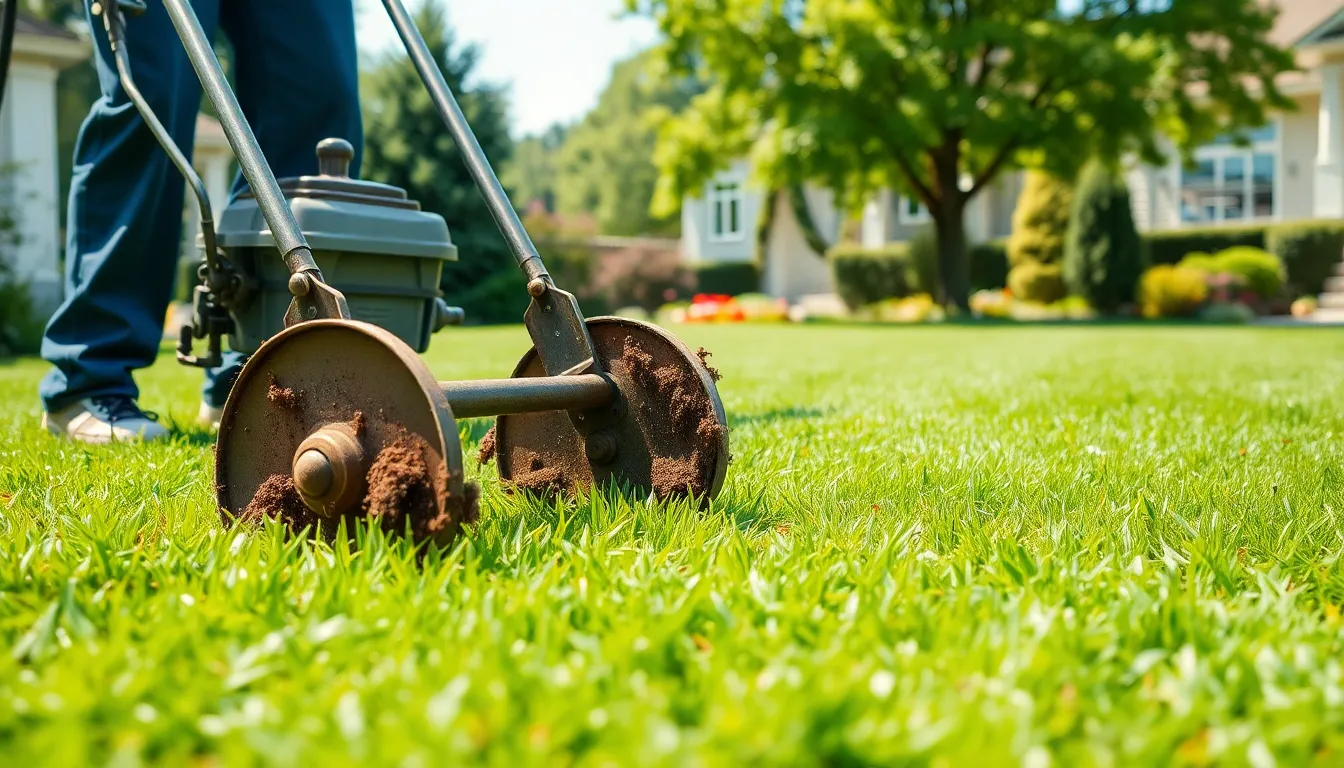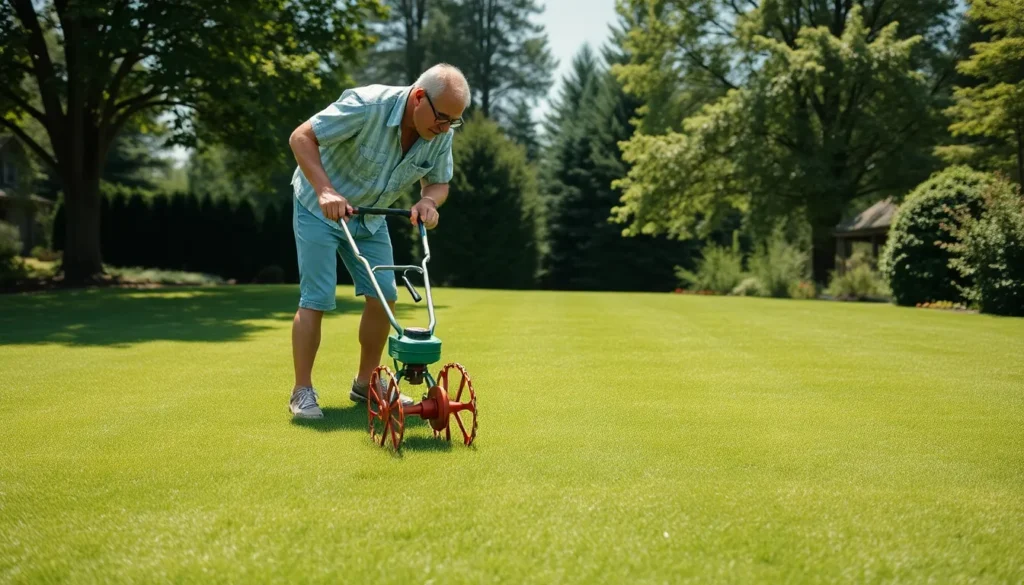Table of Contents
ToggleA lush green lawn isn’t just for show; it’s the envy of the neighborhood and the perfect backdrop for summer barbecues. But without proper care, that dream lawn can quickly turn into a patchy disaster. Enter aeration, the secret weapon for lawn enthusiasts everywhere. It’s like giving your grass a refreshing breath of fresh air—literally!
Understanding Lawn Aeration
Lawn aeration involves perforating the soil with holes, allowing air, water, and nutrients to penetrate deep into the grass roots. This process benefits the lawn by improving root growth, enhancing water absorption, and reducing soil compaction.
Compacted soil makes it difficult for grass roots to thrive. Aeration reduces this compaction, promoting healthier grass and reducing the need for excessive watering and fertilization. Heavier soils, like clay, especially require aeration to improve drainage and nutrient availability.
Frequency of aeration varies based on specific factors. For example, lawns subjected to heavy foot traffic may require aeration at least twice a year. Conversely, lawns with lighter use can often benefit from annual aeration in the fall or spring, depending on regional climates.
Choosing the correct aeration method adds to the effectiveness. Core aeration, which removes plugs of soil, offers superior results compared to spike aeration, which simply creates holes.
Timing also influences results. Aerating during the growing season enables grass to recover quickly. In contrast, aerating before dormancy can lead to slower recovery but can still enhance lawn health in the long run.
Understanding the unique characteristics of individual lawns is crucial. Different grass types and local climate conditions play a significant role in determining the best aeration schedule. Proper assessment before planning aeration ensures the highest benefits for the lawn.
Benefits of Aerating Your Lawn

Aerating a lawn provides multiple advantages that contribute to its health and appearance. Understanding these benefits helps homeowners appreciate why regular aeration is essential.
Improved Soil Compaction
Aeration directly reduces soil compaction. Compacted soil limits grass roots’ ability to grow and access air. By perforating the soil, aeration creates channels, improving airflow in the root zone. This process increases the soil’s capacity to retain moisture. Enhanced moisture retention means lawn grasses absorb water more efficiently. Healthy roots can develop deeper, ultimately leading to a more robust lawn. Moreover, aerated lawns exhibit greater resilience to drought and other environmental stressors. With reduced compaction, grass varieties thrive and maintain their aesthetic appeal.
Enhanced Nutrient Absorption
Nutrient absorption improves significantly through regular aeration. Aeration allows fertilizers and organic amendments to penetrate deeper into the soil profile. As nutrients reach the root zone, grasses access essential minerals more easily. This enhanced nutrient availability promotes vigorous growth and lush green color. Aerating regularly reduces the need for excessive fertilizer applications, saving homeowners money. Roots become stronger and healthier, ultimately resulting in optimal lawn health. Homeowners also enjoy the long-term benefits of a vibrant, thriving yard with proper aeration and nutrient management.
How Often to Aerate Lawn
Understanding how often to aerate a lawn helps maintain its health and beauty. Frequency depends on various factors that affect lawn condition.
Factors Influencing Aeration Frequency
Foot traffic plays a significant role in determining aeration needs. High foot traffic lawns require aeration at least twice a year to alleviate compaction. Soil type also matters; clay soils compact more easily, necessitating more frequent aeration, while sandy soils retain air and moisture better. Grass species influences aeration frequency; some grasses thrive with less disruption while others benefit from frequent aeration. Local climate conditions should not be overlooked; warmer temperatures for cool-season grasses require strategic timing for optimal results.
Recommended Aeration Schedule
A general recommendation suggests aerating lawns in the spring or fall. Spring aeration is suitable for cool-season grasses, promoting growth during the active season. Fall aeration enhances the recovery of both cool and warm-season grasses before winter dormancy. For lawns with moderate usage, annual aeration suffices. Heavy-use areas may benefit from aeration twice yearly, balancing recovery with soil health. Observing lawn conditions and adjusting the schedule accordingly ensures maximum aeration benefits.
Best Practices for Lawn Aeration
Lawn aeration requires timing and technique for maximum effectiveness. Perform core aeration for best results, as it removes soil plugs and allows for better penetration of air and nutrients. Consider the season when scheduling aeration; early spring benefits cool-season grasses, while fall aeration prepares lawns for winter dormancy.
Frequency plays a crucial role in effective aeration. Lawns with high foot traffic typically need aeration at least twice a year, while those with moderate use usually benefit from annual aeration. Observe the condition of the lawn to make adjustments; if compaction issues arise, more frequent aeration may be necessary.
Equipment choice matters for achieving desired results. Select aerators that create adequate holes in the soil, promoting optimal air and moisture flow. Walk behind the machine instead of dragging equipment; this ensures consistent coverage across the entire lawn.
Executing proper care after aeration enhances the benefits. Water the lawn thoroughly immediately after aeration, as this helps the soil recover quickly. Fertilization following aeration allows nutrients to penetrate deeper into the roots, further enriching the soil.
Monitoring local climate conditions is essential for scheduling. If heavy rainfall occurs, postpone aeration until the soil dries sufficiently. Adjusting the aeration schedule according to weather patterns can significantly improve lawn health over time.
Maintaining the right grass type in conjunction with aeration practices promotes overall lawn resilience. Certain grass species respond better to specific aeration schedules, so understanding this relationship aids in achieving a lush, vibrant lawn.
Regular lawn aeration is vital for achieving and maintaining a healthy vibrant yard. By understanding the specific needs of a lawn based on foot traffic and grass type, homeowners can determine the optimal aeration schedule. Whether it’s twice a year for heavily used lawns or annual aeration for lighter traffic, the right approach ensures improved soil health and enhanced grass growth.
Selecting the appropriate aeration method and timing further maximizes benefits, making it easier for grass to thrive. With proper care post-aeration, including watering and fertilization, the lawn will not only look great but also withstand environmental stresses. Prioritizing aeration as part of a lawn care routine leads to a lush green space that enhances outdoor enjoyment.







